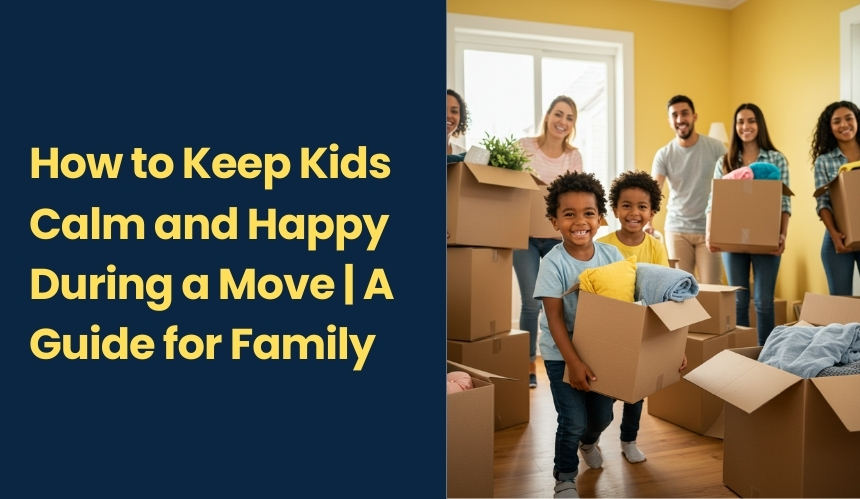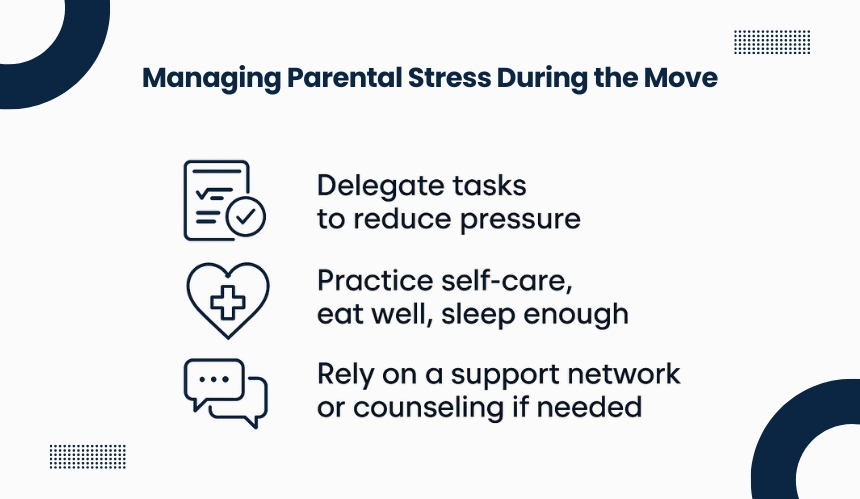
- Phil
- August 29, 2025
How to Keep Kids Calm and Happy During a Move | A Guide for Family
Moving into a new home is often described as one of life’s most stressful events, and when children are part of the journey, the complexity increases. Parents preparing for relocation face not just the logistics of packing and transportation but also the delicate responsibility of guiding their children through a period of uncertainty.
From preparing children emotionally to involving them in small moving tasks, families can transform relocation from a source of tension into an opportunity for growth. This article will cover preparation strategies, emotional support, travel-day tips, and post-move guidance to help children stay calm during relocation.
Pre-Move Preparation: Setting the Stage for a Smooth Transition

Preparing children for a move begins long before the boxes are packed. The way parents handle the early stages can shape how children feel about the entire transition. Offering clarity and structure helps reduce fear and gives kids a sense of control.
How Should Parents Break the News of Relocation to Children?
Children process change differently depending on age. Younger kids respond well to simple explanations paired with visual aids, while older children appreciate open conversations that acknowledge their feelings. Timing is also critical. Sharing the news early allows children to ask questions and gradually adjust to the idea of leaving.
Why Does a Moving Timeline Matter for Families?
A structured timeline creates predictability, which is comforting for children. Mapping out important dates, such as school transfer deadlines, farewell gatherings, and packing milestones, provides reassurance and minimizes last-minute stress. Displaying the timeline in a family calendar helps kids visualize the process and stay engaged.
What Packing Strategies Keep Kids Comfortable?
Packing can feel overwhelming for children when all their belongings are suddenly tucked away. To prevent anxiety, parents can start with non-essential items while leaving comfort objects and favorite toys accessible until the last moment. Using color-coded labels or stickers allows children to identify their boxes quickly and adds a playful element to the process.
Emotional Support: Addressing Kids’ Fears and Anxieties
A move disrupts the familiar rhythm of a child’s life, and it’s natural for them to feel nervous or unsettled. Emotional reassurance is just as important as physical preparation. Parents who recognize early signs of stress and respond with empathy can make the transition smoother.
How Can Parents Recognize Signs of Moving Anxiety?
Children show stress in age-specific ways. Toddlers may regress in toilet training or become unusually clingy. School-age children might complain of stomachaches or headaches linked to worry. Teenagers may express resistance, irritability, or silence rather than talking openly. Being attentive to these subtle signals helps parents intervene before stress builds up.
What Reassurance Strategies Work for Different Age Groups?
Tailored reassurance is most effective. Younger kids respond well to playful storytelling or picture books that explain moving in simple terms. School-age children benefit from clear, factual conversations that validate their concerns while pointing out positives. Teens appreciate honest dialogue, involvement in decision-making, and being trusted with responsibilities.
How Can Parents Maintain Stability During the Transition?
Validation is the key to security. Instead of dismissing fears with quick reassurances, parents can acknowledge feelings by saying, “I understand you’re worried about leaving your friends” before guiding children toward solutions. Encouraging kids to share memories and helping them stay connected with old friends makes the move feel less like a loss.
Practical Involvement: Turning Kids into Helpers Instead of Bystanders

When children feel left out of the moving process, uncertainty can quickly turn into frustration. Giving them meaningful ways to participate helps shift their mindset from passive observers to active contributors. This involvement not only reduces stress but also instills a sense of ownership over the new chapter ahead.
How Do You Handle Loneliness After Moving Out?
The emotional shift of living alone can feel overwhelming. Homesickness is natural, but building new routines helps ease the transition. Stay connected with friends and family through regular calls or visits, while also exploring local communities, clubs, or gyms.
If loneliness persists, consider adopting a pet, which provides companionship and routine. Developing hobbies such as cooking, art, or fitness can also fill the silence with growth and satisfaction.
What Moving Tasks Are Suitable for Kids?
Assigning age-appropriate responsibilities helps children feel useful without overwhelming them. Young kids can gather toys, sort stuffed animals, or decorate their moving boxes with stickers. Older children can help pack books, fold clothes, or create checklists. Teens may assist with labeling, light lifting, or organizing items for donation.
How Can Parents Make Packing Fun for Kids?
Turning chores into games transforms the experience. Time challenges for packing, scavenger hunts for misplaced items, or rewarding completed tasks with small treats keep children motivated. Gamification reduces boredom and shifts the focus away from stress.
Why Does Giving Children Responsibility Build Confidence?
Even simple choices, like deciding what goes into their “first-night bag” or arranging personal items in labeled boxes. Responsibility reassures children that their role matters and that they have some control over the moving process, which lowers anxiety levels.
How Does Involvement Strengthen Family Bonding?
Working together as a team encourages cooperation and communication. Parents modeling calm, organized behavior while involving their kids builds trust and unity. Shared efforts also create positive memories that balance out the challenges of relocation.
Travel Day Tactics: Keeping Calm on the Road or Flight

The actual moving day often brings the highest stress for children. Long hours on the road or time spent in airports can lead to boredom, restlessness, and meltdowns. Preparing in advance with comfort items, entertainment, and structure helps ensure a calmer experience.
What Should Parents Pack in a Travel Essentials Bag?
A well-stocked bag can prevent frustration during delays or long drives. Snacks, water, comfort toys, blankets, and changes of clothes keep children physically comfortable. Age-appropriate activities such as coloring books, puzzles, or headphones with music or audiobooks provide distraction and reduce complaints.
How Can Families Balance Screen Time with Offline Activities?
While tablets and handheld devices offer instant relief, too much screen time may increase irritability. Alternating digital entertainment with offline games like “I Spy,” reading, or drawing keeps kids engaged without overstimulation. Having both options available gives parents flexibility depending on the situation.
Why Does Routine Matter on Travel Day?
Children feel calmer when their usual schedule is respected. Planning stops around mealtimes, ensuring nap breaks for younger children, and keeping bedtime rituals consistentcreates a sense of normalcy. Predictability provides comfort, even in an unfamiliar setting.
How Can Parents Minimize Travel Stress?
Small gestures, like offering reassurance during turbulence or explaining how long each leg of the journey will take, give children confidence. For younger kids, counting down to arrival or using visual timelines helps them grasp the process. Staying patient and modeling calm behavior encourages kids to mirror the same attitude.
Settling In: Helping Kids Adapt to Their New Home

The first few days after a move are critical for how children perceive their new environment. A thoughtful approach to settling in helps them feel safe, connected, and excited about their new surroundings.
How Can Parents Help Kids Feel at Home Quickly at a New Location?
Creating familiarity right away reduces uncertainty. Setting up children’s bedrooms first and unpacking their favorite belongings makes the new space feel personal. Hanging familiar posters, arranging toys, or placing a favorite blanket on the bed provides instant comfort.
Why Should Kids Be Involved in Room Setup?
Allowing children to make choices about their space, such as arranging furniture, picking wall colors, or deciding where toys go, gives them a sense of ownership. This involvement helps transform a strange room into their sanctuary, easing emotional adjustment.
What Role Do Routines Play in Post-Move Comfort?
Re-establishing daily routines quickly signals stability. Mealtimes, bedtime rituals, and weekend family traditions should resume as soon as possible. Even familiar music during dinner or reading time before bed reinforces continuity and reduces stress.
How Can Parents Make the New House Feel Familiar?
Introducing familiar elements throughout the home, such as displaying family photos or setting up the same kitchen layout, creates a sense of recognition. Small consistencies remind children that while the setting has changed, the essence of family life remains the same.
Stress Management for Parents: Keeping Yourself Calm for Their Sake

Children mirror the emotions of their parents, which means a parent’s stress can amplify a child’s anxiety during relocation.
Recognizing personal triggers and staying grounded is essential for guiding kids calmly. Simple practices like deep breathing, short breaks, or light exercise can reset your mindset. Delegating tasks to family members or professional residential movers also reduces unnecessary pressure.
Self-care isn’t indulgence, it’s a necessity. Eating well, sleeping enough, and keeping a support network close allows parents to maintain patience and positivity. When parents manage their emotions effectively, children feel safer and more reassured throughout the transition.
Expert Tips & Professional Help: When to Call in the Pros
Sometimes moving with kids becomes overwhelming despite preparation. Professional movers experienced in family relocations can handle logistics, giving parents more time to focus on their children’s emotional needs. Babysitters or family members watching younger kids during moving day also prevent chaos.
For families facing persistent stress, relocation counselors or child therapists can provide guidance tailored to children’s adjustment challenges. Recognizing when help is needed ensures that both parents and children move through the transition with confidence and support.
If you’re ready to make your move easier, A Great Moving Crew offers family-friendly moving services designed to keep the process smooth and stress-free. Their team takes care of the heavy lifting so you can focus on keeping your kids calm and happy.
Frequently Asked Questions
How far in advance should families start preparing kids for a move?
Ideally, parents should begin discussions about the move as soon as plans are confirmed. Early communication gives children time to process the change, ask questions, and emotionally prepare. This approach reduces last-minute stress and helps them adjust gradually.
What are some ways to keep school transitions smoother for children?
Visiting the new school beforehand, meeting teachers in advance, and sharing information about extracurricular opportunities can help children feel more confident. Maintaining communication with the school staff during the adjustment period also reassures kids that they have support in their new environment.
How can parents help children maintain friendships after a move?
Encouraging kids to exchange phone numbers, connect through video calls, or send letters helps preserve existing bonds. Scheduling occasional visits, if possible, reassures children that moving doesn’t mean losing important friendships.
What if children show ongoing resistance even after the move?
Some children may take longer to adapt. Parents can support them by maintaining open conversations, creating positive new experiences, and, if necessary, seeking guidance from a child therapist or counselor who specializes in relocation adjustment.
How do families manage pets alongside children during a move?
Pets can add to the stress if not planned for. Assigning someone to care for pets on moving day or arranging professional pet transport services allows parents to focus on children while ensuring pets stay safe and calm.

